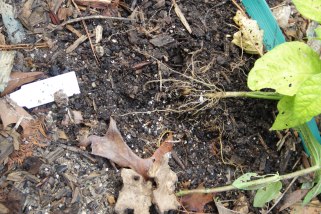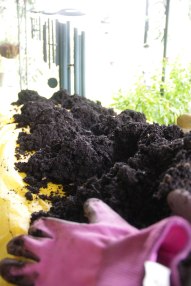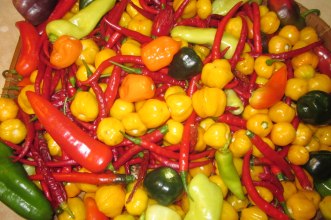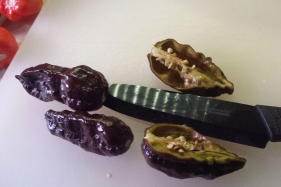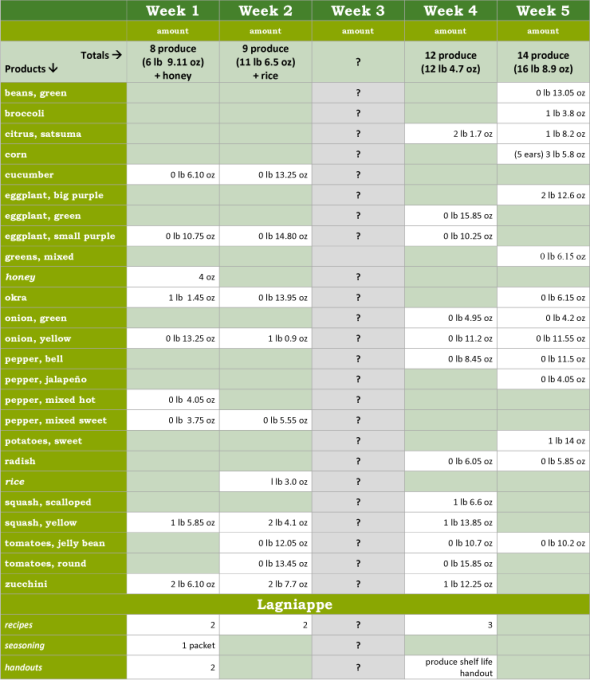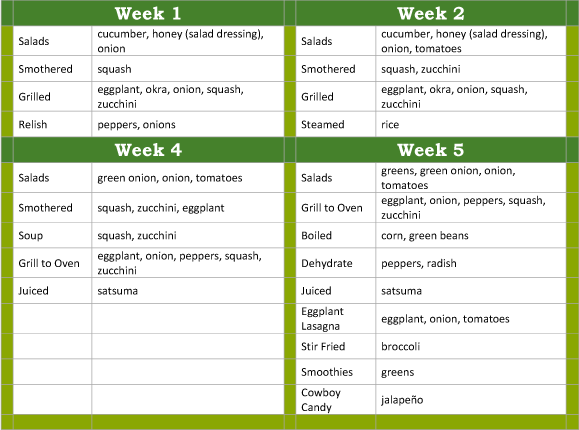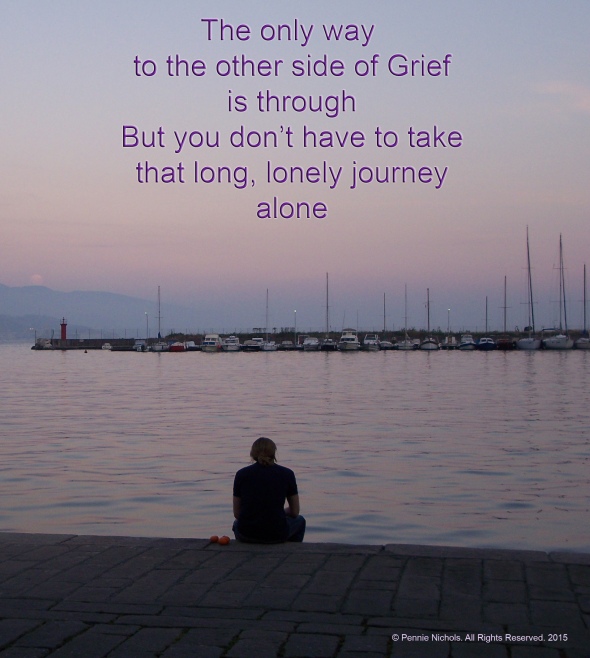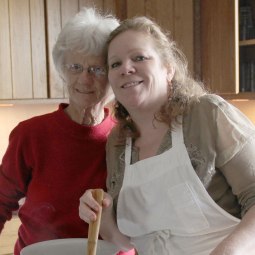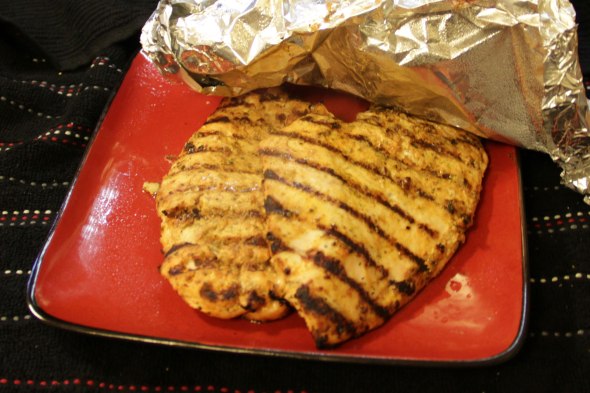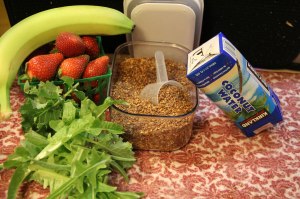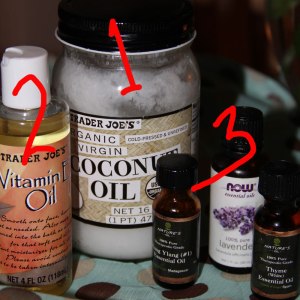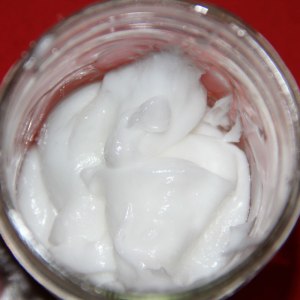Thanksgiving Leftovers

Part 1: A circle of thanksgiving
We stand in a circle holding hands, a tradition that evolved in my parents’ home from a combination two traditions, leftovers, if you will: grace before a meal and gratefuls during meals.
Boil these down for gumbo tomorrow.
Every link in our circle has suffered at least one wrench or break from another link in this circle. Yet, here we are. “First, we’ll take turns expressing what we’re grateful for . . . It can be anything,” to ease the younger links into the tradition.
“I’m thankful for this family . . . “
Gratitude has become a bandwagon for those anxious to reap the emotional, spiritual, as well as fiduciary benefits of thankfulness. Rewire your brain! Relieve stress. Improve sleep. Improve relationships. I ride that bandwagon. Gratitude helps me deal with leftovers of relationships, disasters, even meals.
What are we going to do with all of these potatoes?
In gratitude we push away shortcomings to focus on our strengths, we see beyond our losses to be joyful for our blessings, we displace grudges with forgiveness.
“I’m grateful for this time together . . .”
We acknowledge that, like all families, there have been unfortunate turns in our family. Ours comes back to this circle of thanksgiving, woven with the strength of our love for each other, the joy of the blessings we share, and the magic of forgiveness. And food.
Can we freeze the rest of the cranberry relish?
Thankfulness in many ways is magical. When divides —whether political, religious, social, or emotional— feel irreparably deep, gratitude for the leftover goodness mends, a circle of thankfulness bridges gaps between us.
“I’m grateful to be included in this family.”
We all have at least one thing in common, at least one thing we can be grateful for together.
How many pies?
I’m thankful for common ground.
“. . . and for the children, who are present and engaged.”
My dad closes the circle of gratitude with a prayer.
” . . . and for these blessings, we give thanks.”
We squeeze hands and chime in “Amen” before we dig in and begin creating . . . the leftovers.
Part 2: Leftovers
Stacks of dishes, naps on recliners, impossible puzzles, long walks through the fields, disappointing football games, and then the question.
What should I do with this?
For those of you who tuned in for leftover recipes, here are a few ideas.
Turkey Gumbo
In Louisiana, we often pull the okra and sausage out of the freezer and cook up a pot of turkey gumbo on Black Friday. Online recipes for exact ingredients and measurements are plentiful. This is the basic process.
- Start with a stock.
- Boil the bones alone or with some herbs (bay leaf, oregano, for example) and vegetable scraps (onion ends and skin, a head of garlic cut down the middle).
- Make a roux.
- About 1 cup each of flour and vegetable oil for a big pot of gumbo.
- Slowly heat the flour in the pot until it becomes golden.
- Add oil and whisk until it blends smoothly with the flour.
- Continue to heat slowly until the roux is dark.
- Add vegetables.
- Add chopped onion, bell pepper, and celery (1-2 cups of each).
- Once these are soft, follow with minced garlic (4-5 cloves).
- Add the stock, leftover (and chopped) turkey, Andouille sausage medallions (Italian sausage will do), sliced okra (1-2 cups), and 2-4 tbsp of Worcester sauce (to taste).
- Season (salt, cayenne, Tabasco, black pepper) to taste.
- Bring the gumbo to a boil, then simmer for 20-30 minutes.
- Serve with rice.
Dressing Balls
If you end up with extra dressing or stuffing, make dressing croquettes.
- Work a beaten egg into a bowl of about 3 cups of dressing.
- Form balls (slightly bigger than a golf ball).
- Optional: Fill the balls with cranberry relish or any compatible leftover.
- Poke a hole.
- Fill.
- Reclose.
- Cook for about 5 minutes:
- To fry, roll in a little flour then deep fry.
- To bake, place on cooking sheets and bake at 400º.
- To air fry, place balls in Airfryer and cook at 330º.
Sweet Potato Chips
Leftover baked sweet potatoes?
- Slice the cooked sweet potatoes about ¼ inch thin.
- Season to taste (salt and cayenne or cinnamon and brown sugar).
- Cook.
- 300º for 10 minutes in Airfryer.
- Deep fry for 2-3 minutes.
- 400º for 10-15 minutes in the oven.
I was the last to leave my parents’, which means my mom filled my car with the leftovers she didn’t want. As I repurposed the turkey, dressing, potatoes, and relish, I reminisced about the week our family spent together. I’m grateful for that leftover lagniappe.
Copyright © 2015 by Pennie Nichols, All Rights Reserved.
I’m lifting you up.


Your friend has cancer. Every genuine, heartfelt phrase you want to share sounds cliché and the more you delete and rewrite, the more your words become faded Hallmark sentiments. “How can I express to her how I’m feeling?”
Then you ask yourself, “What can I do? Should I call? No, she’s probably flooded with calls, but what if she thinks . . . ? Maybe I’ll pop in to check on her. No, what if her whole family . . . ? I’ll just text. But I need to do something. I’ll bring meals for the family. But what if someone already did?”
Struggling with these questions after you receive the news is a sign that you might be a truly supportive friend. Thoughtful words and gestures are a good beginning. Thoughtful awareness is an excellent delivery vehicle for your words and acts.
Over the past fifteen years, nineteen friends and close acquaintances have faced cancer. Eight died. Geography, level of intimacy, and personal circumstances were factors in the extent of my connection during their treatment and recovery. While my involvement varied greatly, the struggle with words and acts was a constant. No matter how close I am to the person, physically or personally, I want the things that I say and do to make a difference, even if as simple as a fleeting smile.
I ambitiously set out to write a list of dos and don’ts for interacting with a friend who has cancer. After reaching out to friends with cancer stories, I realized the futility of a concrete list. The perfect thing for one friend is the worst for another. What did come from my conversations and ruminations is this list of guidelines, two of which I touched on above, all of which are relevant to caring for friends in any difficult circumstance.
1. Check in.
Let your friend know that you’re thinking about her. If you decide not to call because her lines are flooded or you’re not sure what to say, send a card, an email, or a text. If you’re struggling with the words, let that struggle go and use the words you find. Even a short text that borders on cliché can make a difference to a friend who is going through a tough time.
Keep checking in. Your friend will be flailing through waves of emotions, physical hardships, and practical concerns throughout her treatment and beyond. Even if you’re not one of the primary people taking care of her, check in regularly to let her know you’re thinking of her or to offer help. When treatment is complete, check in some more. The emotional and physical impact of cancer treatments can linger well beyond the last treatment date.
2. Tune in.
Be thoughtful and aware. Each cancer journey is unique. One friend explained: “the most important thing is to remember that every person is different, and we all have different problems / obstacles / challenges, which means there is no single appropriate response.”
Tuning in is listening. If you ask: “How are you feeling?” or “How are you doing?”, listen to the response.
Tuning in is also practicing thoughtful awareness of your friend’s support network, personality, and receptiveness.
If your friend has a family or community support network, communicate with that network so that you’re not duplicating or hindering the efforts of others. If there is no “built-in” support network, team up with other friends to create one.
Your friend’s personality is your guideline for interactions. Is she stoic or does she need a little extra boost? Is she all business or does she enjoy a laugh? A little levity can be helpful, but only if she’s ready for it. During a chemo treatment, the art therapist told my friend, “You’re back! Remember me?” My friend responded no. The therapist asserted, “Yes, you were here last week,” which wasn’t true. After the fourth insistence, I responded, “Well, she’s got that bald thing going on. They all look alike, don’t they?” The art therapist stood stunned. My friend belly-laughed, and she was ready for that.
How communicative is your friend? Is she open to sharing details about her treatment and feelings? Give your friend a chance to open up if she wants, but don’t pry her for details she’s not ready to share.
3. Be specific about what you can do.
Spell out it out. Don’t carelessly toss your friend an extra burden: “Let me know if you need anything.” Specify: “Can I mow your lawn this weekend?” or “I’m available to run errands for you for two hours on Friday.”
Your friend may not know what she needs; even if she does, she may not reach out. Tuning in and being specific can help. I asked two questions in one afternoon:
“Can I get you anything from Costco?”
“No, I’m good.”
Fifteen minutes later:
“I’m at Costco. Do you need any salmon?”
“Yes, that would be great. And can you check to see if they have any LaCroix?”
In the end, my friend requested five things. After tuning in to her habit of responding, “No, I’m good,” I called back with a specific question. This helped her think through and verbalize what she needed.
4. Be a thoughtful visitor.
Don’t pop in. During treatment, your friend may feel weary and not particularly social or presentable. Call ahead, make sure it’s a good time, and specify how long you will stay. “I can visit for fifteen minutes tomorrow if you like. I’ll bring ice cream.”
Don’t linger. Be cognizant of how your friend is feeling when you arrive. She may not be up for the visit after all, or she may be feeling anxious and need the company. One friend explained that the fifteen- to twenty-minute visits from a friend with a listening ear and comfort food were the best.
Don’t react. Avoid: “This is just dreadful!”, “I can’t believe this is happening to you!”, or “This is a piece of cake! You can do it.” On the other hand, be open to and don’t sugarcoat the emotions your friend is feeling. Her fear and anxiety are part of her story. If she wants to share those, listen but don’t try to qualify them.
Don’t give medical advice. Well-intended advice is often annoying, even disturbing. If you have information that might be helpful, don’t discuss it. Simply share the website or the book. It’s not your place to prescribe or recommend treatments. Your friend will discuss those with her doctors.
Don’t vent or ramble about inconsequential events. This can be insulting to the friend you’ve come to visit. Sure, she may want to talk about something other than her cancer, but let the communication flow from your friend to you. If conversation stalls, ask about other things in her life. “How is Timmy doing in school?” “Is Olivia still playing soccer?” Or, just sit and allow the quiet presence of companionship.
5. Remember the primary caregivers.
Reach out to the primary caregiver. Although that spouse, sibling, or friend may have meals, errands, chores, and visitation perfectly coordinated, he or she may need some additional support. Check in to find out and offer specific things you can do.
6. Don’t try to own her cancer.
Respect the boundaries. Friends often rush in to help a sick friend. Don’t let that become a competition or complication. Coordinate your efforts, avoid squabbles and pettiness. What you do for your friend and your struggle to find the right things to say and do are valid, but that story is the sub-plot. This is her cancer story. It’s her cancer. Not yours. Quiet support is often the biggest expression of love.
Thanks to my friends who shared their cancer stories and whose thoughts helped me cobble together some guidelines. Specifically, thanks to these ladies.
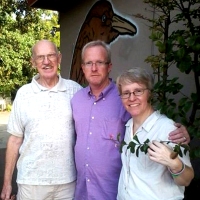
Jane with her dad and brother shortly after surgery
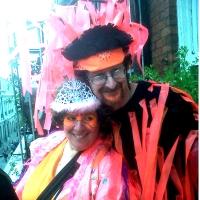
Mim and her husband, both of whom faced cancer

Patti with her two children

Lisa with her sister, who was with her every step of the way
Copyright © 2015 by Pennie Nichols, All Rights Reserved.
A Pepper Apology

Five Reasons I Shouldn’t Have a Pepper Garden
Five Reasons I do
The inception of my pepper obsession escapes me. Peppers went from Yes, jalapeños on my burger! to Yum! Let’s makes some more pepper jelly! to How many pepper varieties can I grow this year?
Growing peppers is fascinating, yet equally frustrating. My modest pepper garden has an extravagant history of false starts, flustered efforts, and full fails. I know at least five reasons I should not have a pepper garden.
1. Shysters

Ají Amarillo, they said. I’ll allow that “ají” in Spanish is almost as specific as saying “pepper” in English, but please. These mature to red, not yellow.
My pepper ventures begin with a bubble of excitement, selecting and purchasing pepper seeds online, imagining what those seeds will become. That bubble swells with the successful seedling, the plant, the flowers, the peppers . . . And Pop! Wait! This isn’t . . . What kind of pepper is this? I want a refund! But the line is disconnected and emails go into cyberwasteland. Shysters!
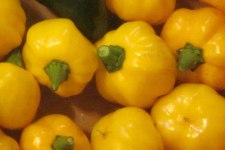
The seeds for these were sold to me as ghost. Um, no! The worst part is I fell in love with them, but I’m not sure what they are and they didn’t reseed.
2. Broken promises
Some plants keep their promises. Peppers, like the seedy seed vendors, are often renegers. My pepper seed success rate stands at about 20%, and that´s probably an exaggeration. The low performance rate is only part of the treachery. Sometimes the plant that produces a fabulously perfect pepper —Yes! That’s the seed I ordered!— exhales its last puff of oxygen days after its one and only pepper. Heroic efforts fail to perk up the limp leaves of these one-pepper wonders. I never trust a pepper plant.
3. Critters
Critters burrow, critters nibble, and sometimes critters crush the plant. As infuriating as these delinquencies can be, the most annoying critter habit of all involves my carefully placed plant labels. Why do they move my plant labels? Are they playing toss the plastic? Having pretend sword battles? My plants and my pseudo-scientific efforts to track and positively identify them often fall victim to the shenanigans of nocturnal critters. Note to self: must map the garden plot.
4. Insects
The beginning of any season is bliss. The beds are fresh, and that order-day bubble of excitement billows with hope. The seedlings will mature, the seeds will produce what the label says they should, the newspaper and mulch will control the weeds . . . But one bright morning, Pop! The stink bug convention is in full swing! Before long, my garden becomes a playground for stink bug babies, tiny other-worldly nymphs with creepy red bodies. I battle other insect invasions, but stink bugs are the most aggressive. I only use organic pesticides, so short of grabbing the leaf-footed bugs and crushing them against my thighs, there is no instant termination. I dust them with diatomaceous earth, coat them with neem oil solutions, shoo them away, and pray my dreams aren’t infested with them.

I’ve eked out a few peppers from this plant, but it has been unhappy since seedlinghood.
5. Peppers
Peppers are bratty, lazy children. No, not yet! I’m tired! I’ll germinate tomorrow. Too much water! I need more water! Additionally, the peppers that manage to survive the critters and insects are prone to almost any disease, bacteria, or fungus that gambols through the garden. My inchoate gardening skills are part of the problem, but a PhD in peppers could not sufficiently school me on the essentials and afflictions of my pepper plants.
The list of frustrations goes on. Even success can be frustrating because the yield is never just right. Too few to follow the recipe or too many to use before the peppers surrender to mush.
Why am I still pampering pepper plants?
Five possible reasons:
1. Challenges

I spy candied scotch bonnet, pickled pimento pepper, pickled pizza pepper, pickled planet pepper, chocolate ghost jelly, angry ginger (scotch bonnet) jelly, and candied jalapeños.
I love a challenge. This one goes beyond negotiating my way around seed shysters, nocturnal critters, and alien insects. This challenge has culinary and intellectual branches. What can I make with this pepper? How can I showcase this pepper’s attributes without killing a friend? The more I learn about peppers —from names and types of plants to different canning and storing methods—, the more I know I don’t know. I’m sure that even my last pepper plant will teach me something, a lesson in survival, a story of surrender, an anecdote about its indigenous history, or maybe a simple moment of grace as I accept the firm, perfect pepper my plant offers.
2. Grounding
Gardening, especially cultivating peppers, takes me out of my head and into the dirt. Many gardening acts feel holy: harvesting compost and worm castings, organizing seed trays, mixing organic elements. The garden is my quiet room, where I sow and weed thoughts, pamper ideas, and whisper affirmations. I find myself in the failures and bounty of the plants, especially my pepper plants.
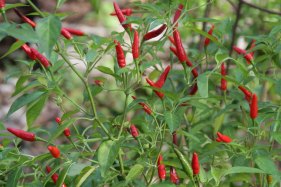
Ascent peppers are easily confused with Tabasco peppers. No one understands the name on first try. Scent peppers? No, ascent peppers. Cent peppers? No AH-scent. Sent? Writes down the name.
3. Excitement
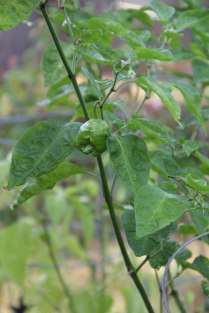
This baby moruga scorpion looks innocent enough, but it is a member of the pepper family that is being touted as the hottest in the world.
Discovery, exploration, and, of course, heat. Each year I discover new varietals we must try and explore recipes and techniques. What are we having for dinner? I still can’t answer, Peppers! But peppers are the exciting compliment, brightening a dish with bold flavors and color. Elation escalates with rising Scoville ratings. Even people who can’t tolerate hot peppers are fascinated by heat. They will watch with anticipation as a friend bites into a spicy morsel and dance with excitement when the friend´s eyes tear up from the heat. Like many pepper addicts, I’m on a quest to grow the hottest varieties available. My mission, however, is divergent. I aim to tame. I dance with excitement when I harness the hottest devils and chaperon them into palatable jellies, sauces, and relishes.
4. Beauty
Peppers are art —my garden canvas, my kitchen palette, my pepper gallery. The pepper laden limbs, a basket full of ripe peppers, jars of pickled peppers, the goat cheese log draped in bright pepper jelly. Beautiful art. Although they will never be the reliable what’s-for-dinner vegetable, peppers are a splendid extravagance, the aesthetic bounty I harvest and share with friends and colleagues.
5. Peppers
Peppers are my garden children, unpredictable attention seekers. Watch me dance! Watch me shine! Listen to my story! Did you know I can . . . ? The peppers that survive my 80%-plus failure rate are worth the frustrations and stink-bug nightmares. I shamelessly show them off to anyone who gives me a moment. I parade my pepper jellies at parties, share pepper photos, fill gift boxes with pepper delicacies. I love peppers. No apologies.
Notes and tips for my fellow pepper enthusiasts
Not all seed vendors are trustworthy. So far, these are vendors I do trust: Territorial, ChilePlants, and Peaceful Valley.
This is a list of some of the positively identified peppers that I’ve successfully cultivated. The list of failed attempts is longer.
alma paprika, ancho, ascent, banana, various bells, Bulgarian carrot, Caribbean (or maybe Bolivian?) red, cayenne, cayenne thick, chocolate ghost, fireball, habanero, ghost, jalapeño, NuMex Jo Parker, moruga scorpion, moruga scorpion yellow, pizza, planet, purple jalapeño, scotch bonnet, Serrano, sheepnose pimento, sweet chinese giant, Tabasco, Trinidad scorpion
If you harvest seeds for the next season, clean, dry, and store them in sealed bags or containers in the freezer.
Pre-soaking seeds in solutions of saltpetre or citric acid can help overcome stubborn germination.
Start the seeds in seed trays or hydroponic systems.
Start early! I start making seed trays in late January and early February, but many of my pepper plants don´t start performing until late summer or fall. They can be painfully sluggish.
If you live in a warm climate, many of your peppers can winter over. Pamper them through the cold months, and protect them from the occasional freeze.
Copyright © 2015 by Pennie Nichols, All Rights Reserved.
My CSA Adventure: The First Five Weeks
CSA stands for Community Supported Agriculture.
I joined one for the first time this year. My excitement was met with:
- But you already have a garden!
- Your mom has a garden!
- You frequent the farmers’ market!
- Why!?
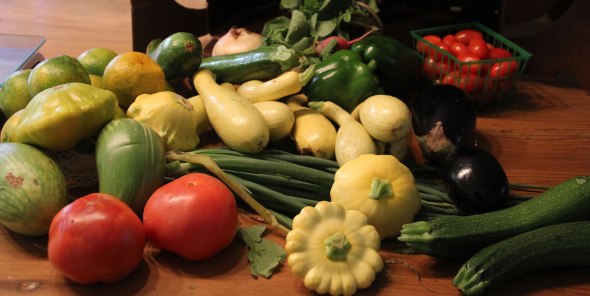 That didn’t stop me. I’m finishing up my fifth week of waxed boxes and so far the only vegetable that escaped me was a cucumber. At week five, I have just two regrets: that slimy cucumber and week 3 (out of town and missed my box).
That didn’t stop me. I’m finishing up my fifth week of waxed boxes and so far the only vegetable that escaped me was a cucumber. At week five, I have just two regrets: that slimy cucumber and week 3 (out of town and missed my box).
For general information and history about CSAs, visit Local Harvest.
This post is about my CSA experience, the content of my waxed boxes, and how I used it.
My CSA is Luckett Farms. I found out about them through friends who were already participating in the program. When I knocked on the garden gate, the CSA was in mid-season and not taking any new members. While I waited to join the next season, I read about the program and decided which box size best suited our empty nest.
Luckett Farms offers three share sizes: Senior, Average, and Abundant. I chose Average Share.
- But you already have a garden!
- Your mom has a garden!
- You frequent the farmers’ market!
- Why!?
Disregarding the possibility that I was biting off more than we could chew, I chose Average Share. I’m a little greedy. I wanted at least one of each thing. I had a couple of habits in my favor: I cook almost every day and I can and dehydrate produce at least once a month, sometimes weekly. If push came to shove, I could shove what we couldn’t consume, can, or dehydrate into our upright freezer. (Note: These are important strategies for CSA members).
My first pick-up day finally arrived. My friend, another veggie aficionada, went with me to claim my first box.
“That’s it?” my friend moaned. She rapped on the door of the home (maybe they can explain). No one answered. She peaked into several boxes as I retrieved my notes from the car.
“Yep. That’s it. That’s the right size.” We were both a little disappointed.
When I returned home, I decided to document my CSA venture because I knew the question was coming: “Did we save money by doing this?”
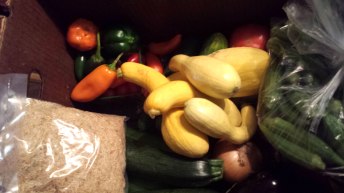
Week 2 of the CSA: the box almost doubled in size, and included locally grown rice!
I pulled out my scale and measured. This first box had eight items of fresh produce weighing a total of 6 pounds and 9.11 ounces. Luckett Farms promises at least eight items. They had delivered that, plus honey, a packet of seasonings, and a couple of recipes. I spoke with a friend who had participated in the CSA. She reassured me that the content of the boxes would vary from week to week not only in selection, but in abundance. (Note: The Local Harvest’s tips is an important read for potential CSA members.)
I took heart. I had already concluded that, even though my first “harvest” was less than I had expected, it was worth the $25 dollars. Based on my friend’s experience, I could expect more abundant harvests in future boxes.
I continued to weigh and document my harvests, except week 3 (dang it!), which, according to the newsletter, included mixed greens, scalloped or patty pan squash, and red beans.
What did I find in the boxes I did collect? Here it is in a nutshell box. To my delight, the number of items and total weight increased each week.
Except for one badly bruised tomato in week 4, and stings” on a squash, the produce was beautiful and fresh. We consumed (or stored) all but the one cucumber that turned on me.
This is what we did with our super-fresh vegetables.
We started out with loads of okra. When I have more than I can use, I typically dehydrate it, then grind it to use as a thickener for soups. Because my dehydrator bit the dust on week 1, I discovered grilled okra. This recipe from Southern Living includes a dipping sauce.
We enjoyed zucchini and squash (also plentiful) grilled, smothered, stir-fried, and in soups and salads. Some recipes I applied:
- Grill to Oven: Squash/Zucchini (I made mine with chicken)
- Smothered Squash/Zucchini

Cowboy candy and cowgirl syrup
Week 5 has been the most impressive box so far. The most celebrated members of this box were the corn and eggplant. We boiled and ate the corn straight. So sweet! The huge eggplant was perfect! I read five or six eggplant lasagna recipes, then made my own version of mostly this recipe, adding ground turkey and substituting mozzarella and Asiago cheese for the typical ricotta/egg mixture.
My friends get a giggle when I tell them there are peppers in my box. My thing is peppers. Pepper jellies, pepper sauces, pepper relishes, dehydrated peppers, roasted peppers, and it goes on. So what did I do with those jalapeños in my box when I already had a few in the fridge, and many still growing in the garden? I rounded up all my jalapeños and made my own version of Cowboy Candy or candied jalapeños. I have a jar full of leftover jalapeño syrup, which will be great for grill glazing or for that interesting oomph in a dish.
I still have a little time to cook up my sweet potatoes (although they will keep quite a while) and scalloped squash before I pick up box 6.
Am I pleased so far with my venture? You betcha! As I collect weeks 6 through 14, I’ll continue to document the harvests, and maybe I’ll follow-up with more recipes. If you’re considering joining a CSA, I hope this information helps. Keep in mind, CSA models vary, so study up before you sign up.
Copyright © 2015 by Pennie Nichols, All Rights Reserved.
Southern-style Smothered Recipes: Squash or Zucchini

Whether you just picked up some squash or zucchini from the market or your CSA box was overflowing with these versatile vegetables, try smothering them.
Smothered Squash or Zucchini
Ingredients
- 6-8 squash and/or zucchini
- 1 large or 2 medium onions
- 1-2 peppers (bell or red)
- 1 tbsp honey
- ½ c wine
- 1 tbsp olive oil
- butter (optional)
- Seasonings (salt, pepper)
Instructions
1. Prepare the vegetables
- Slice the squash/zucchini into ¼-inch slices medallions.
- Slice the onion into half-round slivers
- Chop or slice the peppers
2. Saute the squash/zucchini, onions, and peppers in 1 tbsp olive oil until tender (about 5 minutes).
3. Add honey and wine. For a richer flavor, add 1-2 tbsp butter. Turn the heat up and reduce (about 5 minutes).
4. Season to taste. If you like heat, cayenne is great condiment for this dish.
Add-ons and Substitutions
- Eggplant works nicely instead of or in addition to the squash/zucchini.
- If you don’t have honey, use brown sugar or agave.
- Add dried or fresh oregano or basil.
Copyright © 2015 by Pennie Nichols, All Rights Reserved.
Grill to Oven Recipes: Squash/Zucchini

When they’re in season, CSA boxes tend to overflow with these vegetables. This is a tasty way to make sure they don’t go to waste.
Grilled then Baked Squash/Zucchini
Ingredients
- 4-6 squash and/or zucchini
- 1 large or 2 medium onions
- 1-2 peppers (bell or red, or jalapeño if you’re going for heat)
- 1 head garlic
- 2-3 fresh tomatoes
- ½ c sundried tomatoes in olive oil
- ½ grated cheese (optional: when I use cheese, I use Asiago. Parmesan, and Romano would also work well. For a creamier dish, use mozzarella.)
- olive oil
- Seasonings (salt, pepper) and fresh or dried herbs
- 2-3 c marinara or tomato-based sauce (Many recipes, like this one, are available online. In a pinch, buy a jar of sauce.)
Instructions
Preheat grill.
1. Prep the squash/zucchini, onions, peppers, and tomatoes:
- Slice the squash/zucchini into ¼-inch slices, lengthwise.
- Peel and slice onions into ¼- to ½-inch medallions.
- Wash peppers and tomatoes.
Brush vegetables with olive oil and season (salt, pepper, or mix).
2. Place garlic head in a square of tin foil. Sprinkle with olive oil then wrap the foil securely around it.
3. Clean and lightly rub oil on the grates with oil (I douse a paper towel in oil, and, using a silicone glove or tongs, wipe the grates).
4. Place all of the vegetables on the hot grill and close. After 5 minutes, turn the vegetables. As you roast the peppers and tomatoes, handle them gently. Remember to turn the garlic as well so it roasts on more than one side.
5. As the vegetables roast,
- chop the sundried tomatoes,
- grate the cheese (if you’re including cheese),
- preheat the oven to 350o.
6. Remove the vegetables from the grill.
7. Prepare peppers, tomatoes, and garlic.
- Remove the charred pepper and tomato skin.
- Open the garlic and peel (the cloves should “pop” out of their skin).
- Chop the roasted peppers, tomatoes, and garlic.
8. Drizzle a little marinara sauce on the bottom of a 9X13” Pyrex pan. Layer.
- squash/zucchini
- peppers, tomatoes, garlic
- marinara
- cheese
Repeat until you’ve used up your vegetables. If you’re using dried herbs, this is where you layer in the oregano, thyme, and/or basil.
9. Place in the oven and cook for 20 minutes.
Add-ons and Substitutions
- For a more substantial dish, grill chicken and add the chicken to your layers, sliced or whole.
- Mushrooms and eggplant can be used with or instead of the squash/zucchini. Brush the mushrooms with oil and grill whole. Slice the eggplant in ½-inch slices, brush with oil, and grill. Remove skin after grilling.
- Substitute leeks for the onions. Slice them length wise (remember to clean them out), brush with oil, and grill.
- For zestier dishes, add lemon zest as you layer, then sprinkle with lemon juice before putting in the oven.
Copyright © 2015 by Pennie Nichols, All Rights Reserved.
Love Is a Four-Letter Word
“You never loved me!”
I didn’t answer back. At the time, I didn’t know how. The accusation wasn’t true, yet there was some truth in it.
I had loved my ex-husband, even in that moment, but my love wasn’t that our-hearts-beat-as-one love. The soulmate, I-can’t-live-without-you “true” love.
A side note: I’m not including in this tangle of thoughts love for children or parents or pets. This is about romantic love.
You never loved me!
I felt the raw pain in his accusation. After three children and more than fifteen years of marriage, there it was, this half-truth squatting uncomfortably on the shards of our relationship.
That moment haunted me for years. The untrue truth didn’t prompt the demise of our marriage (we had other problems), yet for years, I struggled with the notion that I had a defect in my love gears that made me incapable of “true” love.
Is true love a childish fantasy or daydream? I don’t think so. I know couples who have “true” love, who feel they are soulmates. At times, I felt envious. I compared myself and wondered, “Why can’t I have that? Am I broken?”
In an effort to untangle the nature of my love mechanism and hoping to find out what was broken, I committed quite a bit of thought and energy to these questions. I looked in, but I also looked out.
Looking out, I became aware that assumptions often made about “true” love and other relationships fall apart on scrutiny. Couples who feel they are soulmates are not without their ups and downs and missteps. Even soulmates must work on right relationship. Couples who don’t fancy themselves soulmates can enjoy depth of commitment and compassion. Old solid relationships may still have embarrassing middle-school moments, and budding ones often work through hurdles with maturity and wisdom.
Looking out, I confirmed what I already knew: romantic love comes in many sizes, shapes, and tones.
Looking in, I started defining the expectations I had going into a relationship and understanding the qualities I wanted in a partner and partnership. Pretty damn practical. Share in all things domestic, complete projects together yet have projects of our own, communicate with compassion and patience, journey together and journey apart. My list did not include requisites such as “must be my soulmate” or “I would die without him.”
The observations and introspection helped me understand that I wasn’t broken at all. Perhaps I guard my heart, perhaps my love is not “true” love as conceived by many. Yet I would argue that my love is true.
Explain? OK. I love my partner of nine years. I’m still working on domestic equity, but we share, we fuss, we communicate, we have projects, we take trips, and we have independent interests and endeavors. We’re not soulmates, but our love is good. True love? I would say that my love is true, but I would hasten to point out that, if he were to die tomorrow, I would be sad, deeply sad. I would mourn and grieve. But I would not be devastated or feel lost. Is that because he’s not my soulmate? Is it because I guard my heart? I’m not sure what the answer is. I do believe, however, that the “trueness” of my love should not be measured by my dependence on the presence of that person.
For those who would accuse me of settling for a partner I can love instead of waiting for the soulmate I can’t live without, let me assure you I didn’t settle, I chose. We chose each other. That said, I’m not writing this for those doubters. I’m writing this for the other people like me, who, at some point wondered if they were getting it all wrong, if they were incapable of true love, if they were broken because they couldn’t surrender their hearts with abandon.
While we can make generalizations about love, define it, classify it, even qualify it, those intellectual exercises confuse the love we live. I don’t believe in hard edges that define where you cross into or out of true love. Instead of ideals and definitions, I would have been better served as a young adult by this kind of advice:
- Don’t chastise yourself if your love doesn’t fit a standard definition.
- Observe others in love but don’t belittle your love for being different.
- Your unique love journey should start from within, loving yourself, understanding your expectations and needs.
- Be true to yourself and your love will be true.
My ex was a little right but mostly wrong. I did love him. In some ways I still do.
In the end, no matter what size, shape, or tone, love is love. Be true to it.
Copyright © 2015 by Pennie Nichols, All Rights Reserved.
Personality Type? Green, go with the flow
I recently took one of those FB tests developed by a psychologist to “colorize” your personality type.
Green: go with the flow type.
The “analysis” was fairly accurate. I flow.
I “flow” because I’m a little lazy. It takes a lot of fight and energy to beat back the river.
Not to mention the rewards I receive as I float down the river! Like volunteer seed sprays and sunflowers from feeding the birds outside.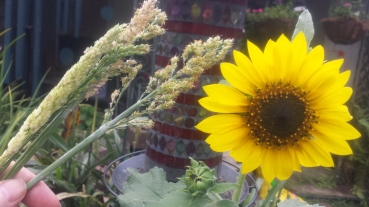
So what if I’m not so careful about cleaning up after the wild critters? I love the sunflowers. My cockatiels love the seed sprays.
Life will provide plenty of opportunities to put your dukes up and fight a good battle. That river of small things? Let it go. Flow as often as you can.
Copyright © 2015 by Pennie Nichols, All Rights Reserved.
Whose story is it anyway?
Sharing can be caring.
 Four times in less than twelve months, I’ve received texts from friends that start something like this: “I have some distressful news . . . ” The bad news unfolded into stories of doctors, hospitals, and scary procedures. The stories belonged to my friends, not to me, but I shared the stories. Mostly to and with other friends, but sometimes I shared these stories that didn’t belong to me outside of my circle of friends. I think I shared the stories responsibly.
Four times in less than twelve months, I’ve received texts from friends that start something like this: “I have some distressful news . . . ” The bad news unfolded into stories of doctors, hospitals, and scary procedures. The stories belonged to my friends, not to me, but I shared the stories. Mostly to and with other friends, but sometimes I shared these stories that didn’t belong to me outside of my circle of friends. I think I shared the stories responsibly.
But how can I be sure?
Normally, I would not ask myself this question, but a couple of the most recent distressful-news stories were shared abusively. So I had to ask myself: “Am I oversharing?”
I don’t think I’m alone in this. We receive bad news from a friend (cancer, divorce, collapse, death, accidents, drug problems), and the wildfire of story sharing breaks out. Unlike yesteryear when stories moved slowly as they navigated landlines, rotary phones, and handwritten letters, today’s stories are fanned by cellphones and social media, and the wildfire engulfs everyone in an instant.
Most often, the sharing is genuine, a loving effort to let other friends and the community know so that the support network can kick in. In less elevated iterations, the sharing is simply gossip. In its most banal form, the sharing is derisive, a weapon to undermine those who are already suffering.
But what about that place between genuine sharing and gossip? You were there if you ever asked yourself: “Why did I share this with them?” or “Would my friend be upset that I told them?”
My midlife throttle is wide open, and, unfortunately, distressful news is the new normal.
I created some guidelines for navigating those moments I feel compelled to share a friend’s story. Before I unveil them, a tiny confession:
- Being the first to inform another friend about the news can be oddly satisfying. I’m not proud of it, but there it is.
- Not telling a friend’s story can sometimes be less genuine than sharing it.

Remember the genuine vs. gossip, vs. weapon? Along those lines, I roughed out basic levels of sharing to use as a guideline.
- Sharing helps my friend. Does it help spread the news, set up a support network, and so on? If yes, share. If not, next question.
- Sharing helps me. Is it on my my mind, does it impact my performance or mood, am I expanding the prayer circle, can I share it without violating my friend’s trust or privacy? If yes, share. If not, next question.
- Sharing is part of a casual conversation outside of the circle that includes my friend. At this point, the only relevant question is: “Does it violate my friend’s trust or privacy?” If yes, don’t share.
For me, there are no more questions. If you made it this far and think there should be more, these are the definite don’ts:
- Sharing is just an anecdote. If it is just gossip, don’t share.
- Sharing is an excuse. If this is a way to get out of work or an obligation, an excuse to ask for money, do not share.
- Sharing is a weapon. Wow. You’re not a friend.
The golden rule applies. Your friend is distressed. He/She needs a good friend. Be good. Share responsibly.
Copyright © 2015 by Pennie Nichols, All Rights Reserved.
Open letter to a lost friend: Six Dollars and a Deadly Secret

This is one in a series of open letters to lost friends.
Dear Sandy H,
When I remember you, filaments of anger are still tangled in the jagged edges of my sadness.
The first call came on a Sunday morning in October. The conversation began with your typical Southern notes of greetings and inquiries. Your turn and you responded, “Oh, I’m fine,” adding after a pause, “I need a favor.”
“Sure, Sandy, whatever you need.”
We had that “It’s been years but it’s like we’ve never been apart” grace in our amity. Months or years might slip away, but we could pick it up. It had been nearly five years since our last visit. Fit to be tied that night: your father had died, you hated your mom, and the will had wrecked your life .
“Is something wrong?” I asked.
“I need to borrow six dollars.”
“Six dollars?”
“Yeah, I just need six dollars?”
The inception of our friendship was a Shakespeare lit class. You commuted to attend classes, so our friendship never extended into the evenings or weekends. I loved listening to stories about your derailed marriage. You were a non-traditional student before that was a thing and the first divorced friend I had. Even though our friendship didn’t go beyond swooning over our lit professor and sharing snorts over things people said in class, I valued the time together.
After graduation, I moved to your city for grad school. We kept up on the phone but our visits were only occasional. You continued to be that peculiar friend. You lived in elegant condos with fine furniture; my other friends and I holed up in noisy apartments or dilapidated houses. You cruised around in a sporty VW with leather seats. We sputtered to class in used cars with worn fabric seats and failing headliners.
“Well, sure. I’m happy to give you six dollars. Did they turn off your water? Your lights? You can come over if you like.”
“No, no. My car is out of gas, so if you could bring me six dollars, . . . I’ll pay you back.” This odd request was new to our relationship but it wasn’t surprising.
At the end of those two years of grad school in your city, I stopped by your condo to say good-bye before I left for a new phase of grad school in Austin. You were in a huff that day. You had always been angry with your mom, but today you were also bickering about your dad and your credit card. “They won’t let me use the damn card unless I pay $300 first!” you carped. Still creditcardless, owing a big chunk of money on a bigger chunk of debt sounded exotic to me. The icing on the cake: “And daddy wants me to pay my own car insurance now!”
Steven warned me, “This sounds very suspicious,” as I was leaving to take you six dollars. It’s okay, I explained, adding that you were a little eccentric, had probably maxed out all of your cards, had a fight with your mom, and just needed some gas or milk. What could it hurt? Six dollars?
I didn’t recognize you at first. Arms wrapped across your abdomen, as you wait for your dog to mark her territory in a patch of grass. Your hair was matted into a flat up-do, your face was swollen, your skin ruddy and blotched, and your linen clothes were torn and stained. Even from my car I knew that you were draped in a rancid cloud. You didn’t sound like this on the phone. You never sounded like this.
I did my best to collect myself as I parked the car. Handing you a $20 bill from an ATM because I didn’t have six dollars: “Keep it.”
Your eyes brightened. “Thank you so much. I’ll pay you back. I promise. How are you?”
“No worries. I’m fine.” My desire to leave was not as strong as my desire to understand. “Do you need anything else? A ride to the gas station?”
“I need a ride to Hi Nabor?”
“Sure,” I said, realizing it wasn’t for milk or eggs.
The books and movies I enjoy revisiting most are the ones with the big “Gotcha!” twist at the end. The ending you didn’t see coming. Even as I waited for you in the car, I started revisiting all of our visits. I had missed something. How could I have missed it?
You limped to the car holding Parish. “Do you mind?” Her matted and discolored coat camouflaged her breed. Shih Tzu? Poodle? “Of course,” I responded, regretting the absence of towels to drape across the seats. You jumped agilely into your diatribe. The details, impossibly tangled in my memory now, were basically the same as our last visit: “My life is crap since dad died, I hate mom, the will was unfair.” The only saving grace in your life was this stinking (but very sweet) dog.
No idea what to do, I offered food. “While you’re in the store, I’ll grab us some lunch, and we’ll catch up, OK?”
“Please don’t leave me,” you implored, doddering out of the car. I promised I’d be back. You watched as I drove across the parking lot to the drive-through. Your fear was real.
When I returned, you were waiting, paper bags clutched to your chest, oblivious to the looks of passersby, relieved when you finally saw me.
At your house, even an “excuse the mess” hostess plea wouldn’t have prepared me. Holding the boxes of food, I turned on my heels, looking for a free surface, a place to sit in the battleground of slain fine furniture: the carved wood accent chair snapped in half, the porcelain lamp in pieces, the once-plush leather sofa gutted, springs and stuffing protruding. The condo was bulging with the smell of urine, ammonia, excrement, and rotting food. Circling, circling.
You plopped into your spot on the dead couch and pointed at an injured but standing accent chair: “Sit there.” I handed you one of the boxes, then sat carefully on the edge of the chair. Your mood had brightened, and I knew why. You had tucked the brown bags behind the cracked desk by the door. The hundreds (yes hundreds) of cheap vodka bottles (every possible size) and diet Coke cans under and on top of the coffee table were my cue to the contents of the brown bags I had enabled.
I tried to follow the frayed threads of your stories. Your limp was from an accident that nearly killed you. “Damn doctors. They were mean to me and didn’t put the right kind of pin in my foot. Didn’t they know who my dad was!?” Your doctor dad. You needed your meds but your mom wouldn’t take you to the clinic. No, I shouldn’t take you to get gas, You hated those people at the Circle K. And could I believe that your family wanted to take away this condo your dad had left to you!? Times were bad. You even sought out free meals at churches when you had gas to get there.
I spied Parish pooping on a throw pillow close to the dining table and began to rise to take care of it.
“Oh, that’s OK. Don”t worry about it.” Could you be serious?
It had been fifteen years prior, yet it was typical of those initial years. “Isn’t it wonderful?” you had said, sweeping your arm to indicate the carpet. “I love to vacuum. It makes me feel like everything is in order. Everything will be all right.”
This was a new you, surrounded by piles of dog poo and urine stains. Parish even had poo on her bed pillows, next to piles of canned dog food that you had dumped on it.
I was feeling ill. I knew you wanted me to leave. Eyeballing your brown bags, you told me you needed a nap several times and became increasingly agitated when I didn’t take the hints. I needed to get a number, a name.
You sunk into the couch and into another tirade about your father. I could see the area of the couch responsible for your matted up-do. You beat the loose stuffing for each syllable of “I’m just so angry,” and I understood that, as frail as you seemed, you had broken your own furniture.
After acquiring a few numbers, I left you and drove home with my windows down, my tears a bitter cocktail of anger, sadness, and confusion. I was still sharing my bewilderment with Steven when you called an hour later. “I feel much better now. Thank you for coming by.”
I was prepared for your next I need a favor call. “Sandy, I won’t bring you money for alcohol. I’ll bring you food, take you to the clinic, or help with an errand, but that’s all.”
This wasn’t the first time you had heard this. Without reaction, you said you understood. I imagine, though, that you threw the phone and beat the I’m.so.angry out of the couch stuffing after we hung up.
We interacted more in the subsequent ten months than in the previous twenty years I had known you. Clinic visits, rehab lobbies, grocery runs, AA meetings, Tex-Mex lunches, resume help. I tried to sort the chronology of our twenty years of infrequent visits with that life you lived: your accident, the expensive rehab clinics, the DUIs, the move to Florida, the boyfriends. I was baffled by my ignorance of those fierce formations and events that had developed beneath the crystalline waters of our chats.
I finally met your mom. You had been forthcoming and accurate about her. She called when you had dislocated your shoulder. You couldn’t remember the tumble down the stairs of your condo. A hospital visit and arm brace later, you had no choice but to stay with your mom until you could use your arm. One night after I had brought groceries for you and your mom, you followed me to the door. “I’m going crazy,” you whispered wide-eyed. “You’ve got to get me out of here!”
When you were finally at your condo again, I started receiving phone calls from your mom. “Have you heard from Sandy?” I sometimes stopped by to check on you. Through a crack in the door, the response was always the same: “I’m okay. The damn phone broke again.” I doubt you remembered those drive-by visits.
The last call came on a September afternoon. I had never met your twin brother, and this was only the second time I spoke to him. He wasn’t crying at first. “Sandy is gone,” he explained. “I was calling to pick her up to watch a Saints game with us. When she didn’t answer, I figured she broke the phone again.”
Your brother was an alcoholic too. He was successfully recovering. I often wonder about his recovery versus your struggle. Maybe his wife and two children gave him more motivation to recover? You had Parish, but Parish didn’t even require a dish for her food. Many alcoholics have family responsibilities and still fail, but perhaps more often than not, family helps.
Your brother and your niece went to pick you up. Your door was unlocked. She found you on the floor in your kitchen, dog poo, rotting food, and an open fridge. Your brother started sobbing at this point in the story. I think he regretted sending his daughter in instead of going in himself. Your heart had given out, drowned in the violent waves of alcohol.
At your wake, a computer ran a series of photos of your fifty-five years, focusing mostly on the first thirty. Birthday parties with your twin brother, beach trips with friends, fancy dinners with your family. I wasn’t in any of the photos. I don’t think I have a single photo of the two of us. I wasn’t part of that life you had lived under the surface of the Sandy I knew. The photos of friends and family were sad reminders of the relationships that had crumbled under the burden of your disease. I realized as I left the wake that I was that acquaintance that teetered on the edge of friendship, I was the last number in your little black book. The last call for alcohol.
That little bit of anger still stuck in my craw is not about your dark secrets, not about the transparent manipulation of our last ten months, and certainly not about being last on your list. I’m angry that there’s nothing I could have done.
I thank you for the laughter of our first twenty years. I love you for the lessons of our last ten months. I hope you’re at peace.
Pennie
Copyright © 2015 by Pennie Nichols, All Rights Reserved.
Open letter to a lost friend: Adrift

This is one in a series of open letters to lost friends.
Dear Mona Z,
I remember our last visit. Sitting on your patio with newborns in our laps and toddler girls playing in the yard, we laughed, exchanged mommy stories, daycare plans, and anticipations for our families. The afternoon was pleasant, yet on that day I understood that our friendship had reached its natural end. 
When our chat turned to houses, you explained that your in-laws had recently purchased a home in the most exclusive neighborhood. My lack of awe galvanized your campaign to impress upon me the import of that move. Honestly, I was unaware of the status of that neighborhood then, and now, even in the knowing, my dearth in reaction would remain. The undulations were already tugging at our interests. One slipping over the ebb, the other rolling with the flow.
You nudged the conversation to the furniture you had recently purchased and the updates you had made to your nearly new home. I felt happy for you and a little amazed. I quietly reflected on the futon that my husband and I still sat on every evening, in a home full of hand-me-downs and holdovers from college. You had visited our home briefly just before we moved the furniture in, exclaiming as you opened doors and peeked around jambs: “Oh. They didn’t paint the closets.” They hadn’t. Eight-months pregnant and still working, I wasn’t gonna. Even knowing the merits of freshly painted walls, the tenor of my tastes never drew me into a closet, not even my own, to inspect the paint.
As you described and recommended your maid, I floated further away, aware already that house cleaning would always plummet off my priority list in favor of other endeavors. I drifted back as you explained: “. . . except the toilets. I prefer to clean the toilets my way.” Even now, when I clean toilets, I remember and wonder, “Am I doing it right?”
As we talked about our children, the undercurrent drew me beyond the breaking waves of our conversation. Children in our sails, our courses would diverge absolutely. Soccer vs. dance, music vs. football, volleyball vs. cheerleading. In the blink of a childhood, we would be oceans apart. Our girls played happily that day. Even though they grew up less than ten miles away from each other and later graduated from the same university, that was their last play date. Washed away by their moms, with their moms?, on eddies away from the circle.
The end was natural and necessary.
We were incidental friends, drawn together by the men we dated in college. Riding the wave of their friendship, we camped on beaches and in cabins, skied on Lake Maurepas, danced into the morning at discos. When that wave melted into the shore, I moved on, but you stayed and married your college sweetheart. We chuckled about him that afternoon on the patio, how he had run out in his drawers that morning to rush the garbage cans to the street for pick up.
I had been back for almost a year, and we had clumsily picked up our friendship, scheduling play dates and lunches. Many friendships rise up with the grace of “it’s like we were never apart.” Ours didn’t. I resisted the end because you had been a good friend. You had given me one of those perfect moments that even now I remember.
The moment came an hour or two before dawn when we were riding the college wave. The guys were still outside drinking and playing cards. We were crashing, yawning comments about the day. Then you said it. Clearly. Honestly.
“You should leave him, you know.”
For a moment I thought you were in my head. How did you know?
“He’s going nowhere.”
The gnawing nowhere of my relationship with him. You spoke what I felt but needed to hear. I had been afraid to break the circle because I knew it would break many.
As simply and to the point as you had been about cleaning toilets, “He’s not right for you.”
Despite the haze from the wave of alcohol that had washed us to that moment, despite the darkness of that hour and the oceans of years between us now, that moment is still crystal, bright in my mind.
The ex-boyfriend had come up from time to time in our conversations, perhaps even on our last patio day. He wasn’t an awful guy. Just not the right guy. You had helped me embrace that.
Some friends are forever. Some aren’t. I don’t dwell on the many layers of friendships, intersecting circles of friends, or levels and types of friends. I do splash around a bit to understand the gifts of the people in my life, past and present. Even for lost friends, not all is lost. I may have to dive into the cool depths to find the treasure, the shiny little something we shared. I always find it.
We said good-bye that afternoon, made promises we couldn’t keep. Internet, social media, and obituaries have kept me marginally informed. Your daughter is a beautiful young medical professional and your handsome son is pursuing a degree in film. Your dreams with your college sweetheart withered in the tedium of day-to-day. I hope the dissolution was not too painful. I hope you’re happy.
I don’t miss you, Mona. Even twenty-three years ago, I knew the friendship wasn’t sustainable. I do, however, remember you fondly. Odd little memories, the clean toilet, the “neat” burger (no condiments, no vegetables for you, just meat on a bun), the straight smile with the tiniest of curls on each end, and the honest truth. I hope your friends appreciate your frankness and know how to bring a tiny curl to your smile. You were a good friend to me. I still love you for that.
Pennie
Copyright © 2015 by Pennie Nichols, All Rights Reserved.
I didn’t plan to be a mom

For the first quarter century of my life, I boasted that I’d never marry, that I wouldn’t have children.
I would write, travel the world. I would be a nomadic wordsmith.
Yet here I am, mother of three adult children. Despite an empty nest and a portable work-from-home career, here I sit, on the patio of my home of 23 years.
Where did I go wrong? I didn’t. While I didn’t plan to be nor get here this way, I made the choices that set me on this journey, sometimes to float and let the current take me.
Was my life adventure diminished? Absolutely not. My mama journey has included travel, lush paths, white water rivers, mountains, beaches, boat rides, horse back rides, soccer and volleyball games, swim meets, concerts, road trips, and every roller coaster in every theme park we ever visited.
This journey —which isn’t over— includes good days and bad days, brilliant moments and miserable mistakes, heart split wide open (mostly with love but sometimes with ache), and just about every cheesy greeting-card cliche about being a mom.
How do I celebrate Mother’s Day?
Casually at best.
My firstborn arrived on a Mother’s Day. So sure, Mother’s Day has a special place in my heart. But let’s face it Mother’s Day has become like a commercial holiday, with ads that guilt children into sending the card, flowers, a gift, making the phone call, going to visit . . .
- What if she remembers too late to send a card?
- What if he’s working on that day or studying for a final exam or writing a final report?
- What if they don’t have the money to buy a gift or the time or creativity to make one?
This “special” day also brings heartache to some celebrants.
- For children who have lost their mom, the day can be bittersweet and sometimes sad.
- For moms who have lost a child, the day brings a new wave of grieving.
- For the childless woman . . .
Let’s talk about her for a minute.
According to the Pew Research Center, nearly 20% of women between 40 and 44 are childless, and over half of those not by choice.
- For the childless who long for a child, surely Mother´s Day brings a bitter reminder.
What of the childless by choice? Remember? That was my plan.
While Pew RC puts the statistic at around 7-8% of women between 40 and 44, a whopping 45% of my friends (mostly in their 50s and 60s now) are childless by choice. I calculated the same result for both the close-friend and closest-friend pools. Although the stigma of being childless by choice has diminished, it’s there.
- For the childless by choice woman, Mother´s Day can stir her defensiveness against those empty-life prejudices.
In my little world, those prejudices hold no truth. The lives of my childless friends are full, exciting, and often selfless. Many have mom skills, and some have filled in as second moms. Yet this holiday excludes them.
Two more points that should not be excluded.
- Some children have crap moms. They could buy her a house and a car for Mother’s Day and still fall short.
- Some moms have crap children. This day is a poignant reminder of their narcissism.
Am I poo-pooing Mother´s Day?
Yes and no.
When my Mother’s-Day firstborn was still a baby, we went to a one-year old’s birthday party. My friend joked that the celebration wasn’t about her son, but about her, the day she labored to bring this new person into the world. The first birthday was a Mother’s Day. I liked this idea! I announced the same sentiments for all three of my children’s first birthdays. It’s not your birthday, it’s your mother’s day!
Similarly and conversely, the most important part of Mother’s Day for me is my children. Not the card. Not the flowers. Not a gift. Certainly not guilting them into cooking, cleaning, or taking me out to eat (although I confess I tried that once or twice ). Mother´s Day is about this unexpected path, a journey I never imagined for myself. Motherhood. My children.
I celebrate my mom and her impeccable model of strength and love in action on this day. Most years we have a combined celebration in May: my mom’s birthday (first week of May), my daughter’s birthday, and Mother’s Day. Mother’s Days is never the thing, but one of the things we celebrate in early May.
- Yes. I am poo-pooing the commercialization of Mother’s Day.
- Yes. I am poo-pooing the negative feelings Mother’s Day generates for those who feel excluded.
- Yes. I am poo-pooing the typecasting of women and the complex roles they play in the lives of children.
- No. I’m not poo-pooing having a special day for mom. Maybe it’s the second Sunday of May. But it could be any day of the year. Or many days of the year.
Celebrating motherhood fans out. I reach back with love and gratitude for my mom. I reach forward and love this unplanned journey, my children. I reach more to unfold my gratitude for the friends I have made through my children, and my gratitude unfolds even more tenderly for the friends of my children who are a special part of my life.
Happy Mother’s Day to all of us!
Is all of this to say that I would I hate chocolates in a goblet or a snuggles and a visit from my children? Absolutely not. But if not on the second Sunday of May, any day would do. You’re part of my journey, and that’s what I celebrate.
Copyright © 2015 by Pennie Nichols, All Rights Reserved.
Figs and Promises

My fig tree always keeps its promises.
Sometimes I break promises. Not intentionally. My intentions are to keep any promise I make.
Nevertheless, on occasion my intentions slip away from me.
I wait too long to pick the figs.
Maybe I pick the figs but don’t make the jam or freeze the fruit before the figs develop a second coat of fuzz and collapse into brown fermenting mush.
Then, for completely unreliable, there are years when the weeks of fig laden drooping branches fall off my calendar before I pick a single fig.
I can count on the fig tree. It can’t always count on me.
To be fair, I have a lot more going on than my fig tree and its fruit. Yet this spread-thin life that leads to broken promises bugs me. Promises, like deadlines, suffer a lexical erosion when we pile our days high but spread ourselves thin. This is a trend in many work environments and, to me, the trend feels infectious.
I don’t want the trend to spill into the pool of promises I make to friends, family, and myself. So this is my checklist for personal and friendly promises.
Making a promise
- Be thoughtful. In other words, avoid hasty promises, whether to a friend, to a colleague, or to yourself.
- Be realistic. Part of the thoughtfulness includes a reality check. If your promise involves time, check your calendar. If it involves money, check your wallet. If it involves your physical and emotional energy, check in with yourself. Avoid making promises you know you can’t keep. Being that can-do hero is not always prudent.
- Do your best. If you make a promise, do your best to keep it. Suddenly in over your head? Having a change of heart? I don’t advocate the hell or high water route. Sometimes the best we can do is circle back to reevaluate, redefine, or, if necessary, retract a promise.
Oops! The birds ate all of the figs before you picked a single one. What now?
- Be honest. If you can’t keep the promise, admit it. Everyone at some point in life has to bail on something for some reason. The key to right relationship in those situations is not the goodness or badness of the reason, but the communication. Let anyone else involved know. Sometimes the only person involved is you. Yes, be honest with yourself.
- Be forgiving. If you’ve been thoughtful, realistic, and honest and you’ve done your best and it still doesn’t work out, the broken promise isn’t a lie. You stumbled and scraped a knee. Don’t rub salt into the wound.
Dear fig tree:
I am grateful for your deliciously extravagant promises and I know you will deliver.
I hope to harvest gallons and gallons of your fruit, infuse my jams and sauces with their sweet complexity, freeze what I can’t jam into jars for the slower days. I can’t promise how much I’ll pick, how many jars I’ll can, or how many bags I’ll freeze. But I promise to do my best.
I’m looking forward to the next round of figs. If you’re looking for something creative and delicious to do with your figs, check out this guy. This recipe is very tasty.
Copyright © 2015 by Pennie Nichols, All Rights Reserved.
Boneless, Skinless, and (Yes!) Grilled

The boneless, skinless chicken breast
 I confess that the primary reason the boneless, skinless chicken breast (BSCB) is a staple in my home is because I’m lazy. I don’t want to fuss with bones and skin.
I confess that the primary reason the boneless, skinless chicken breast (BSCB) is a staple in my home is because I’m lazy. I don’t want to fuss with bones and skin.
Add to that: the BSCB colors me imaginative and creative because it is one of the most versatile places to start a meal.
And there’s more. The BSCB turns me into a clever, meticulous planner. It is hands down my favorite hack for (not) planning a week’s worth of meals.
So how does a lazy non-planner float gracefully through a week of meals?
- Monday night: grilled chicken. I grill at least eight to ten chicken breasts even when it’s just two of us. Serve them with some grilled vegetables and rarely have a pot to wash when I’m done. The rest of the week is leftover magic.
- Chicken quesadillas on Tuesday
- Barbecue chicken and potatoes on Wednesday
- Stir fry (just warming really) chicken and vegetables on Thursday
- Chicken tossed in pasta on Friday
If I´m really clever and meticulous, I have tasty salads with sliced grilled chicken for lunch all week.
Grilled boneless, skinless chicken breast. I usually start there.
But you’re still shaking your head. “Boneless, skinless chicken breasts on the grill?! They’ll be dry as dirt!”
Not at my house.
What’s my secret?
Sour cream.
Not dollops of sour cream on top of dirt-dry grilled chicken. A sour cream marinade.
The sour cream-based marinade not only flavors the chicken, but is less likely to cause flare ups and will help retain the moisture.
I don’t have “a” recipe. Recipes are a bit like meal planning. I resist and rebel. The good news is I have a process, and if you already have sour cream and garlic at home, you can probably try this process without having to make a special trip to the store.
Sour Cream Marinade
Marinade Ingredients
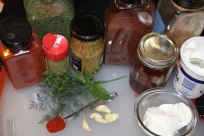
Your marinade can be different every time. Start with sour cream and garlic, then add the herbs, spices, and condiments that suit you and suit the meal.
- 1/2 c sour cream
- 2-4 cloves garlic: if you don’t have fresh garlic, substitute 1/2 – 1 tsp powdered garlic or 1-2 tsp garlic flakes (though fresh is always better).
- sweet: I usually use 1 tbsp honey, but molasses, agave, coconut or brown sugar also work well.
- herbs & spices: 1-2 tbsp dried (more if fresh) herbs and spices. This will completely depend on my mood and the sides that will compliment the chicken. The herbs I like to use include basil, rosemary, dill, oregano, thyme, parsley, and sage. Other spices that I might reach for are chili powder, paprika, cumin, other pepper powders, cinnamon, and turmeric.
- tang: Sour cream is tangy on its own, but I often add a little more tang: 1 tbsp mustard, fresh or pickled ginger, lemon or lime juice, vinegar, or lemon or orange zest.
Process
- Grind all of the ingredients in a mini food-processor or chopper/grinder.

Place sour cream, garlic, and seasonings in a grinder, chopper, or food processor and grind. The color of your marinade will depend on the ingredients you include. This one included honey, paprika, parsley, and dill.
- Pat dry the chicken breasts with paper towels.
- Season the chicken breasts: I use a homemade combination of dried herbs and vegetables, but a little salt and pepper will do.
- Tenderize the chicken breasts: I like to tenderize for a couple of reasons: to work in the seasonings and to “thin out” the thicker parts of the breasts so that they will cook more evenly.

After you pat the chicken dry, season and tenderize. Tenderizing works in your seasonings but also “levels the grilling ground.” Pound the chicken to achieve an even thickness without compromising the composition of the meat.
- Toss the chicken in the marinade: I often only marinate it for 15-30 minutes (I’m truly planning challenged), but you can marinate it longer, even overnight.
- Grill! I start high on a hot grill for and sear each side 2-3 minutes, then turn to med-low for and additional 5-10 minutes, depending on the thickness.
- Cover and sweat: when I remove the breasts from the grill, I like to cover and seal them with foil until we´re ready to serve.

While the chicken is marinating and the grill is heating, take out a platter and some foil. Have them ready to receive the breasts hot off the grill. Seal and allow the meat to sweat for a few minutes.
- Eat!
Soon to come, recipes processes for ways to use and/or repurpose the grilled BSCB.
Enjoy!
If you came here looking for grilling “rules” or techniques only to find a little side note for a grilling process, here are a few useful sites that range from geeky to practical: The Science Of Grilling, 13 Best Grilling Tips, 31 Grilling Tips from Grill Master, Steven Raichlen, Estimating Grilling Times.
Copyright © 2015 by Pennie Nichols, All Rights Reserved.
The Best Smoothie in the World

Is the smoothie you just made.
With a little bit of planning and some getting over that take-out-the-blender dread, there is no reason you can’t have the best smoothie in your kitchen and at your fingertips year round.
Some of you are here just to nab a recipe, so, before the tutorial on how to make your own very best smoothie, here’s a recipe that works for me:
A Smoothie Recipe
Ingredients
- 1 banana
- 8-12 oz coconut water (or milk)
- 1 cup (or a handful) of kale, spinach, or lettuce
- 6-8 frozen strawberries
- 1 tablespoon flax seed
Directions
- Place the banana, coconut water, and greens in a blender. Blend for a couple of minutes until you have a smooth green base.
- Add the strawberries, and blend until smooth.
- Add the flax seed, blend just a bit.
- Pour it up and drink.

Hack Note: No one likes to clean the blender. While you’re sipping your smoothie, fill your blender about a third of the way with warm water, add a drop of dish soap, blend, wipe as necessary, empty, and rinse. Done!
Note: Frozen fruit is not a smoothie requirement. It’s what I prefer. But if you’re using fresh fruit instead, add a cupful of ice to your recipe.
After I wrote this tutorial, I discovered Tracy Russel’s site. Check out her site for in-depth nutrition information, focused primarily on green smoothies, and great recipes. This tutorial is to help you plan and have what you need at home to make that smoothie you love.
Now back to the tutorial for…
How to Rock the Best Smoothie
Ingredients
You can start with as few as TWO basic ingredients:
- liquid base
- fruit
You can make it green by adding a THIRD:
- liquid base
- fruit
- green (kale, lettuce, spinach, greens, green superfood powder)
You can supercharge with a FOURTH ingredient:
- liquid base
- fruit
- green (kale, lettuce, spinach, greens, green superfood powder)
- plug-ins/add-ons (chia, flax, hemp seeds; powdered shake supplements)
So why is the best smoothie in the world the one you just made? Because, you will make it with the ingredients you like. That’s where a little planning comes in handy.
Plan Ahead
The Liquid
I make my smoothies with coconut water, but you can use milk, almond milk, yogurt, or juice. By keeping these on hand, you’re already on your way to on-demand smoothies. If your fruit choices already pack your smoothie with flavor and creaminess, water may do the trick for you.
The Fruit
What fruits do you like best? This is the key to the world’s best smoothie. You might want to use two or three fruits. I almost always start with a banana then add a second fruit. Strawberry is my go-to smoothie fruit, but I keep other fruits on hand.
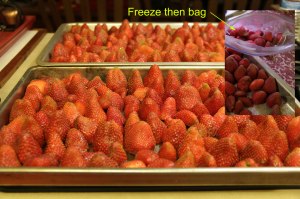
Hack Note: After you overbuy seasonal fruit at the farmer’s market and prepare it for freezing (rinse berries, top strawberries, peel and slice peaches, pineapple, papaya, etc.), distribute the berries or slices on a tray in a single layer. Freeze them overnight, and bag them for the freezer the next day. This avoids giant clumps of frozen fruit.
You can buy bags of frozen fruit, but I prefer to freeze my own. During strawberry and peach seasons, I load up at the farmer’s market. During dewberry and blueberry seasons, I pick berries. We eat what we can fresh, but I freeze most of it so that I can have out-of-season fruit choices for my smoothies year round.
Here are some of my favorite smoothie fruits. You should make your own list.
creamy
- bananas (makes a great creamy base)
- papayas (frozen papaya makes the creamiest smoothie ever)
- avocado (say yes to the green fruit; see this article for recipe ideas: 11 Times Avocado Made Smoothies So Much Better (Don’t Be Weirded Out)
- peaches (smooth and tangy)
- mango (almost as smooth as papaya)
bright
- strawberries (my go-to fruit)
- blueberries (can be pulpy)
- pineapple (sweet)
juicy
- watermelon (this is refreshing and surprisingly delightful in a smoothie)
- cantaloupe
- honeydew
The Greens
Not everyone wants a green smoothie, but if you do, don’t fret. You don’t have to cross town to a specialty store for green smoothie ingredients. Pick up some kale, spinach, lettuce, or any other greens that you like. Remember. This is your world’s best smoothie, so you should choose accordingly. If you don’t often have fresh greens at home, you can keep a tub powdered green superfood in your pantry. It doesn’t wilt.
Many sites tell you that you won’t taste the greens. I do taste them, but they are subtle and, since I like the greens I use, not a distraction from the fruity ingredients.
The Plug-ins/Add-ons
These are the ingredients you choose to enhance the nutrition or flavor of your smoothie. I often choose flax seeds because, like chia seeds, they have anti-inflammatory properties that might help with my arthritis. I’ve recently started using hemp seeds as well. You can also pick up some superfood powder supplements to supercharge your smoothie. If you’re using a green superfood powder in lieu of greens, you’re covered here.
For information on the benefits of flax, chia, and hemp seeds, see this article by Jodi Geigle: 3 Seeds for Supercharged Smoothies.
You might consider adding a flavor enhancer: a teaspoon of lemon or lime juice, a drop of vanilla (or other) extract. Or be brave and add some fresh ginger or basil leaves. This is your super smoothie. What flavor boost do you fancy?
Make it!
- Follow the same basic directions I provided at the beginning (A Smoothie Recipe).
- If you’re using greens, it’s good to blend those well before adding any of the frozen fruit.
- When you’re done, don’t forget to clean that blender!
What is your World’s Best Smoothie?
Copyright © 2015 by Pennie Nichols, All Rights Reserved.
Take Five and Feel Better

A little over a year ago, I had fallen into a pit of negative emotion.
The pit had formed for a variety of reasons: I was working hideous hours and pushing aside personal or domestic interests; the freezes were killing my plants; it was dark by 5:15 p.m. Even though I understood why I was a grumpy curmudgeon, I was having trouble digging myself out of this pit.
So I decided to take five. Five positive measures for myself, each day before noon.
I chose a combination of physical, emotional, and creative measures.
-
Five simple exercises
Not a gym workout, just a few minutes of five exercises to get my blood pumping. Arm swings, toe touches, sit-ups, yoga, curls. I wasn’t scientific about it. I just did five exercises.
-
Five gratefuls and affirmations

Practicing gratitude and affirmations has become popular, and while the practice currently borders on cliché, the power of authentic gratitude is real. I made it a point to do this every morning. Some days I shared them, not on status updates, but with my partner, a friend, or one of my children. Sharing made them more meaningful and powerful. More authentic.
-
Five minutes outside
Working at home, I often pop out of bed and beeline from coffee to computer, where I’ll stay for rest of the day. Even though I keep a garden, I can easily go days without stepping outside, especially during winter. I made it a point to BE outside. Not to take out the trash or water a plant. Just be out there. Soak in the sun, feel the moistness of the fog, listen to the rain, gaze up the pine. Five minutes of just me and the outside.
-
Five minutes of quiet/meditation
For years, I made an effort to meditate 20 minutes a day. I struggled with monkeys chattering in my head. I found myself opening an eye to check the time (how much longer do I have to sit here?). More stressful than quiet, so I stopped. But five minutes? I could do that! Since my Take Five journey began, I’ve worked myself back up to 15 minutes of quiet. When the monkeys chatter too loudly or I peek at the clock, I focus on my breathing. Breathe in for me breathe out for me.
-
Five written sentences for myself
This is huge. This is why I’m here now. I already write. I write a lot. “Rental writing”: work, projects, textbooks. Although I would put aside time for my own words, I often felt spent, too weary to write from the heart. Yet I yearned to “write for real.” I knew writing had to be one of the five. I decided on five sentences before noon. No pressure to be a story, a chapter in a novel, a scene for a movie. Just five sentences for me from me.

Deliberately doing five things early in the day focused on concepts that matter to me was powerful.
While I wasn’t Ms. Sunshine every day, whenever I would start sliding into that pit, I found it easier to get my footing and pull myself up, into the sunshine.
Sure. I’ve fallen all the way into the pit a few times since. The difference is that now, if I’m not already taking them, I make sure I take five. Exercise, be grateful, go outside, be quiet, write my words: these are my five. This practice centers on self and nurturing, and I find it helpful even when I’m not wallowing in a gloomy pit.
How are you feeling today?
If you could feel better, why not Take Five?
What will your five be?
Copyright © 2015 by Pennie Nichols, All Rights Reserved.
Confessions of an Eke Addict

Hi. My name is Pennie, and I’m an eke addict.
I eke things for everything they have. I like to squeeze all the life out of the foods and products that come into our home. A few of my peccadillos will sound familiar to some of you, even if you only slightly struggle with this addiction: boiling chicken bones or shrimp shells and heads to make broths, boiling rib bones to enhance the dog food, using compost buckets instead of garbage disposals, keeping a compost pile, and wishing the recycling truck would pass twice a week instead of once (the regular garbage truck could pass just once a month).
Although I’m an amateur addict, I know I am in advancing stages of this addiction because I have some less familiar habits.

My worms receive a handful of food scraps and coffee grounds about once a week in exchange for the castings they make for my garden.
I keep a second compost bucket for eggshells that I eventually grind for the garden. I have a worm colony that thrives in a tub outside my back door.
I use flat cardboard boxes from Costco for starting seedlings.
Additionally (and this habit may border on eccentric for some of you), I ferment citrus scraps —peels and pulp— in reused plastic bottles to make cleaning enzymes.
To feed my addiction, I cull the Internet for ideas. Pages like Food Parts That Are Surprisingly Useful and DIY Life Hacks: 25 easy ways to reuse commonly thrown items make me jump out of my chair and dance around the room. No wonder I can’t stop. The possibilities seem endless.
Back to my addiction. I sometimes —this is starting to get uncomfortable, but I suppose this is why we’re here— I sometimes try to raise the dead. Dead plants, that is.
This was the week of the dead pepper plants.
I finally faced the fallout from the freezes. Dead pepper plants. Hundreds of cayenne, scorpion, and scotch bonnet peppers, now ghosts, snuffed out in their prime. Even the stems closest to the roots snapped dry, lifeless. I knew it was time to let go. As I took a deep breath and began to harvest the dead peppers to add seeds to my already enormous seed collection, a possible eke path revealed itself to me.
The cayenne peppers (did I mention there were hundreds of them?) were dry and crisp, like the red ones I had harvested and dried out months before to make cayenne pepper powder.
I could grind the cayenne pepper ghosts and make a unique pepper powder!
I was dancing in the dead pepper garden.
Ghost Cayenne Pepper powder! No. That would confuse people and ghost pepper fans would be disappointed. White Cayenne Powder? No, boring. This was making me dance. I needed an exciting name to fit the mood. Cayenne Angel Powder? Possibly, although still tame for the moment I was experiencing. Whatever it will be called, the deed is done.
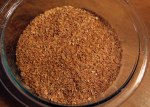
White(ish) Cayenne Powder. Taste notes: not quite as spicy or rich as red cayenne powder, but tasty with a kick. Worth the resurrection.
So that’s my story this week. In a nutshell: I resist letting go. When something goes wrong or when something seems used up, I try one more time, one more thing.
This compulsion is not confined to food, gardening, cardboard boxes, and dead plants, but creeps into my work practices and personal relationships as well. I find ways to reuse and re-purpose the good stuff at work. A rift in a friendship, even a dismal one, is a path to healing and reconciliation, a way to eke more (and better) life out of the connection I have with that friend.
Dead pepper plants become a unique pepper powder. A misunderstanding with a friend becomes a path to deeper communication. I confess I will continue to resist letting go. I will continue to eke out the good in things. I can’t help myself.
Hello. My name is Pennie and I’m an eke addict. I’m not looking for a cure. I’m looking for enablers.
Copyright © 2015 by Pennie Nichols, All Rights Reserved.
Dry Itchy Skin? Try This First.
Can’t focus on what you’re working on because that.itchy.spot! Can’t sleep because you can’t.stop.scratching! Don’t have the patience to deal with people because dry.itchy.skin!
When it hits, it’s exasperating. When it lingers, it becomes excruciating. Even when you take the dry itchy skin to the doctor, the cause is sometimes hard to identify or do anything about. Unfortunately, the go-to medical remedy is typically a steroid cream.
Try this easy DIY alternative before resorting to harsh medications.
Creamy Itch Relief Lotion
INGREDIENTS
- 1 cup coconut oil: I prefer this for my carrier oil in this recipe because I can whip it into a fluffy cream-like lotion. Other carrier oils you can use include almond, aloe vera, jojoba, olive, and sesame, but they will be a skin oil, not a lotion.
- 1-2 tablespoons vitamin E oil: This is optional, but I like to include a little because vitamin E oil heals skin tissue and promotes new skin growth.
- ~ 10 drops of essential oil: The essential oils step is where you play. Combining essential oils can be fun but if you only have lavender essential oil, go with that. See below for a list of essential oils for dryness and itchiness.
DIRECTIONS
- Place the coconut oil in a small mixing bowl, and whip with an electric hand blender or beater, using the whisk attachment. It’s best if the ambient temperature is cool as coconut oil becomes liquid around 76° or 78° F

Whipped coconut, vitamin E, and essential oils
- Add the vitamin E and essential oils as you continue to whip the carrier oil.
- Store in a clean glass jar with lid. You can keep it at room temperature, but if the room temperature is above 75° F, consider refrigerating so that the coconut oil doesn’t melt.
NOTES
My recipes are not scientific formulas, but rather processes. I cull the Internet for information and recipes, then create my own concoctions based on my needs and ingredients I have on hand. I play around with amounts and ingredients until I get something that works for me. You should do the same.
These essential oils can help with dry skin:
- Cedarwood
- Chamomile
- Clary Sage
- Geranium
- Jasmine
- Lavender
- Lemon
- Myrrh
- Patchouli
- Rose
- Rosewood
- Sandalwood
- Ylang ylang
These essential oils can help with itchy skin:
- Agrimony
- Basil
- Bay leaf
- Calendula
- Chamomile
- Chickweed
- Clove
- Geranium
- Jewelweed
- Lavender
- Neem
- Nettle
- Peppermint
- Rosemary
- Thyme
The following are two of the online resources I used to verify the best essential oils to use for dry itchy skin. These sites have a wealth of additional DIY skin remedies.
- One Good Thing by Jillee: http://www.onegoodthingbyjillee.com/2012/11/21-home-remedies-for-dry-itchy-skin.html
- Body Unburdened [No More Nasties]: http://bodyunburdened.com/essential-oils-for-skincare/
Copyright © 2015 by Pennie Nichols, All Rights Reserved.
Existential Blogger
Why am I here?
Full disclosure: mostly for me. But a little for you too.
My selfish reasons: To write. To practice writing. To get my writing edge back. To preen my writing wings. It’s all about getting my creative mojo back after years of mind-squashing editorial work.
Why should you care to read or follow?
That’s truly not my existential question, but I would argue that we have some experiences in common. You don’t have to be a writer or artist to have experienced the forces of that “full-empty” or “everything-nothing” or “got it-don’t got it” paradox.
- Ideas flourish in your head. Great lines, Fabulous projects. Exhilarating stories. Then, out of the car, everything unloaded and put away, sitting at the keyboard, the shards of your thoughts are stuck in the darkest corner of your brain and you’re paralyzed before that blank screen or what canvas.
- You feel tired, sleepy. The cobwebs pull on your brain at work, your eyelids droop like thick velvet curtains at the dinner table. When you finally crawl into your bed to nest in the cobwebs and velvety sleep, awake!
- You’re having a disagreement with a colleague or with your partner. You nail it! You explain calmly the merits of your position. Sometimes you rather nastily point out the holes in his or her arguments. But you nail it every time. You win! In your head. Then the face to face moment comes and fragments of your clever explanation manage to surface, but become jumbled with nonsense (anger, fear, and yes, some poor-pitiful-me whining along with all the things you promised yourself not to say). In the end no one wins.
I’ll explore some of the many brain vs. world/stop-go moments in detail from time to time. You might find your own moment described.
Finally, who am I?
That is arguably the most important and overreaching existential question. It encompasses, what is my purpose?, what is the meaning of (my) life? what . . . ? and why . . . ? and whine and whine.
I’ll keep the whining to a minimum and focus on my hats.
We all wear many hats, and I’ve stood at the edge of this blog for quite a while because I couldn’t decide which hat to wear. I’ve chosen to jump off the edge with my whole closet of hats. I’ll write about things that are close to me, that puzzle me, that are important to me. Some of my hats and interests (in no particular order) that you’ll read about here:
- parent
- gardener
- writer
- jewelry maker and chain mailler
- daughter
- partner
- canner
- cook
- DIY home and beauty products maker (we need a word for this!)
- friend
- peace-maker
- mosaic maker
I hope you’ll join me on a path where many of these hats and interests will intersect, and where many of us will find that we are connected in ways we didn’t predict.
Today I add a new hat. I am blogger.
Copyright © 2015 by Pennie Nichols, All Rights Reserved.



 After the first burn, we were addicted. This is the eleventh year and the tenth time (we missed one year) that we delighted in the ritual of stuffing the tree with our invitations (hellos, welcomings) and dismissals (goodbyes, good riddances) before placing it in the pit for its final fiery moments.
After the first burn, we were addicted. This is the eleventh year and the tenth time (we missed one year) that we delighted in the ritual of stuffing the tree with our invitations (hellos, welcomings) and dismissals (goodbyes, good riddances) before placing it in the pit for its final fiery moments.
